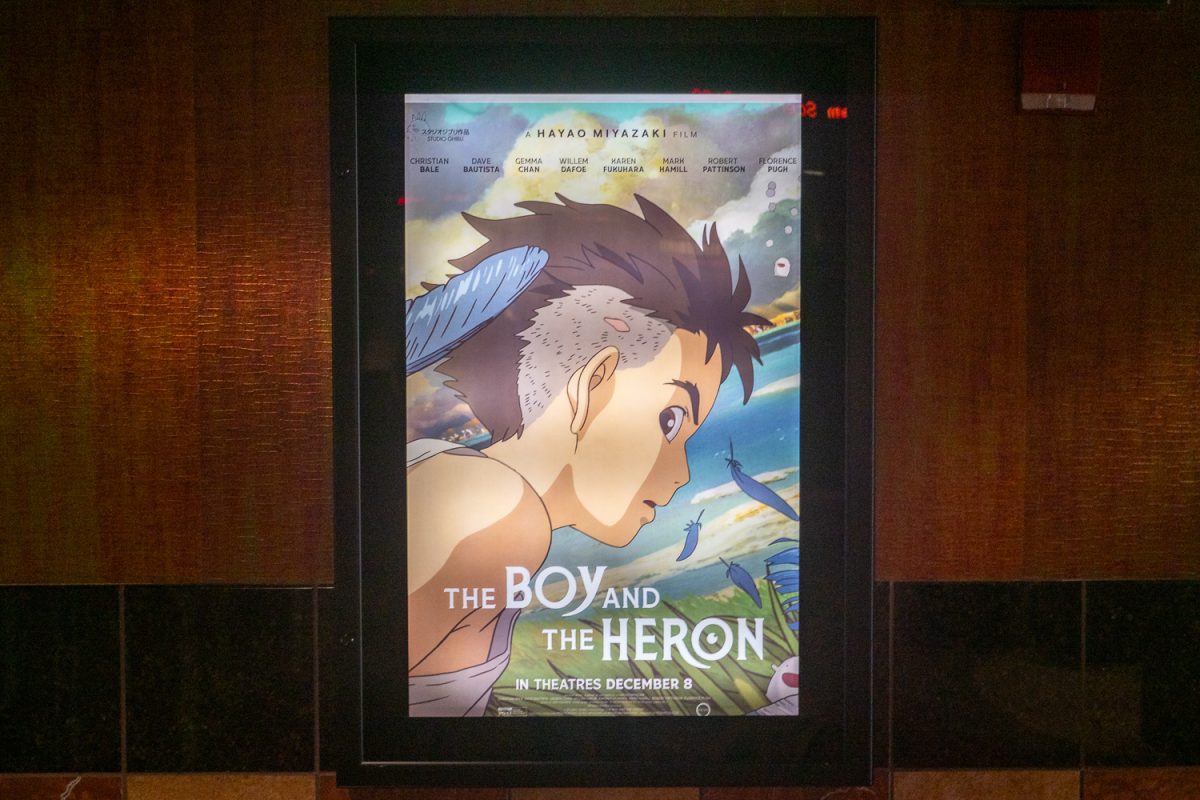Loyal Studio Ghibli fans fill out local theaters as they purchase their advance tickets in anticipation of “The Boy and the Heron.” The film will be released Friday, Dec. 8, in North American theaters.
According to Box Office Mojo, “The Boy and the Heron” has already grossed over 83 million dollars internationally. Initially released under the name “How Do You Live?” in Japan on July 14, the film has received widespread acclaim.
Studio Ghibli is a Japanese animation studio known for its masterpieces, including “My Neighbor Totoro” and “Spirited Away.”
Initially run by directors Hayao Miyazaki and Isao Takahata and producer Toshio Suzuki, the studio is celebrated for its award-winning soundtracks by Joe Hisaishi, the composer of many Studio Ghibli films, including “The Boy and the Heron,” as well as its remarkable art style.
“I think the animation style is distinct. The only thing I can describe it as is that it’s very simplified but not to the point of cartoonish,” said Cameron Kishore, a digital artist and a sophomore at Carlmont High School.
Many films directed by Miyazaki feature a cohesive art style of saturated but fitting colors and meticulous scene composition.
“The art style is very expressive, with some sketch lines. There are a lot of messy frames that work. Studio Ghibli does a really good job with immersing the viewer in action scenes and perspective,” said Olivia Turnbeaugh, an artist and animator in eighth grade.
The intricately detailed animation is not the only reason people love the films.
“The movies are just really enjoyable — they are comfort films,” Kishore said.
Kishore’s sentiment is shared by many. For numerous viewers, watching Studio Ghibli films has been a defining part of their childhood, and seeing the movies stirs up strong feelings of nostalgia.
“I was much more into the movies in fourth or fifth grade because my mom had a ‘My Neighbor Totoro’ CD. I used to watch it in the car at least once a month, so I watched the films all the time,” said Derek Shoji, a fan of Studio Ghibli and sophomore at Carlmont.
Studio Ghibli also enhances its appeal among international viewers by diverging from Western media norms.
Miyazaki is mainly known for his explicit themes centered around environmentalism and stereotype-defying female protagonists, who can be seen in films such as “Nausicaä of the Valley of the Wind” and “Princess Mononoke.”
“They don’t do a Western-style story with a clear villain in the movie. In ‘My Neighbor Totoro,’ the main plot is only introduced in the last 25 minutes of the movie. It’s different from Western movies, where the plot is continuously developed throughout the story,” Shoji said.
Movie critics echo similar sentiments about “The Boy and the Heron.” The unique narrative revolves around a young boy named Mahito Maki who embarks on a journey into a fantastical world with a gray heron.
A significant aspect of the advent of the film was the intentional minimalist promotion. Before the film’s release in Japan, Studio Ghibli revealed a single poster, withholding all information, from trailers to the voice casting list.
Miyazaki initially intended for his audience to watch the film without prior knowledge to immerse themselves. He has since changed his approach for the English-speaking audience, with multiple official trailers and various promotional materials available on the GKIDS Instagram page.
“There were no advertisements when I first heard about it. Recently, I have seen some ads that talk about it, though they’re never actually from the official accounts. It’s very interesting because there’s a reason behind the fact that there are no ads or commercials,” said Tia Phung, a junior at Carlmont who watched the movie’s initial release in Japan.
Still, it is kept to a minimum compared to other movies’ marketing tactics.
“I’ve not seen a single advertisement. I think that’s Studio Ghibli’s magic because they don’t need advertisements. They just need the fan base,” Shoji said.
The film’s popularity can possibly be attributed to Miyazaki, who claimed that ‘The Boy and the Heron’ was his final film.
According to The Verge, Miyazaki has announced plans to quit making feature films three times in his career, with the release of “The Wind Rises” in 2013 being his most recent instance.
However, in an interview with CBC News, Studio Ghibli executive Junichi Nishioka disputed the belief that Miyazaki would be retiring once more.
“He talks about it in his documentary. He was in the middle of making ‘The Wind Rises,’ and he said that it would be his last movie before retiring. Obviously, that didn’t happen. Every time he makes a new movie, he says it’s his last,” Phung said.
The dubbed version of “The Boy and the Heron” features internationally acclaimed actors like Robert Pattinson, Florence Pugh, and Christian Bale, the voice actor for Howl in the “Howl’s Moving Castle” dub.
However, while some might flock to the theaters to hear their favorite actors, a fair portion of people will see the original version in Japanese.
“The popularity from famous actors dubbing lies somewhere in the middle because then it gets to that audience who is interested in voice actors, so it’s pandering to both markets,” Kishore said.












